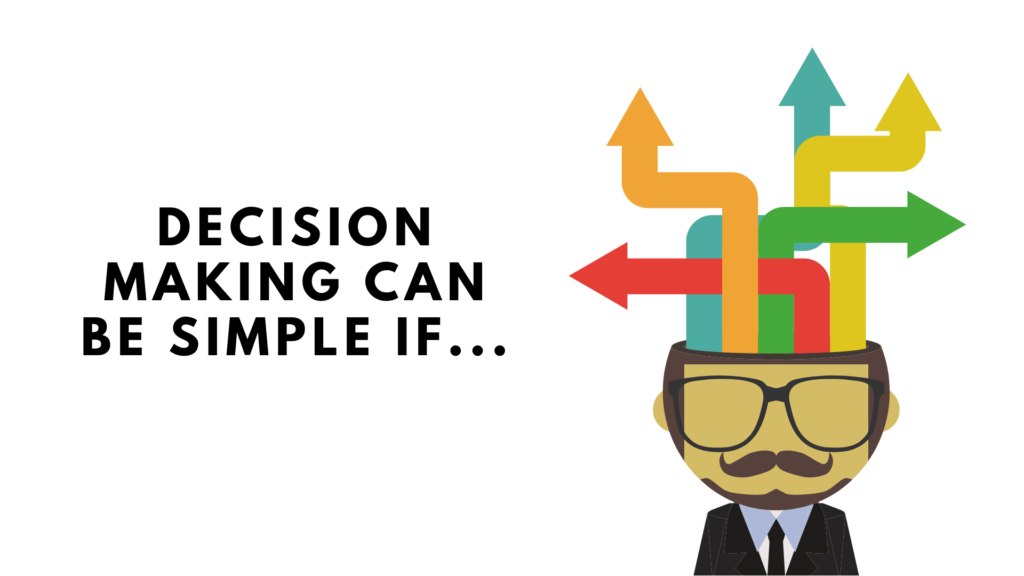There’s no question about it: if you’re starting a business, you must make many decisions near-daily.
You’ll need to decide things such as:
- Which business model to pursue.
- Where to focus your marketing efforts.
- Which domain name to use.
- What design should you create for your website?
- What kind of logo should I use.
- Which JV offers should you accept.
- Which interview or publicity offer to take.
- Which payment processor to use.
- What kind of tools should you use to build your business.
- Which freelancer you should hire.
… and on and on.
The decisions you’ll need to make are nearly endless.
Many of the decisions you make in your business are so important that they’ll significantly impact its success.
Example: If you choose an unreliable web host, you’ll encounter plenty of headaches regarding downtime, corrupt files, or even major security issues.
And that’s just one example. Clearly, you want to strive to make good decisions, which will make everything easier for you in the future.
However, one common decision-making mistake that plenty of people make is that they strive to decide between “good” and “bad” options.
Example: They might look at two web hosts. One of them has plenty of customer service and downtime complaints floating around the web. The other one is generally well-regarded. So the person chooses the “good” web host.
But guess what?
That’s generally the wrong approach to decision-making.
To upgrade your decisions and make even better choices in your business (and your life), you need to choose between the “good” option and the “best” option.
Example: Go back to the standard of choosing web hosting. Suppose you decide on the “good” web host and don’t investigate other options. In that case, you probably aren’t making the best decision for your business. You need to find other web hosts rated well (e.g., all considered good hosts) and then choose the best host.
In short, don’t decide between good and evil. Instead, choose between the good and the best.

Here are three tips to help you accomplish this:
1. Compare Multiple Factors
Don’t make your decisions based on just one factor. Instead, compare your options across multiple elements.
Example: Let’s suppose you’re trying to find the best freelancer for your needs. Some people compare freelancers based on price alone, but that’s a poor way to decide. If you want to find the best freelancer, you’ll need to compare your options based on factors such as:
- Price
- Turnaround time
- The freelancer’s reputation
- The freelancer’s portfolio/quality of work
- The freelancer’s geographic location
And so on.
You should list all the relevant factors to a particular situation. Ideally, rank these factors in order of importance.
In the above example, you are unlikely to meet your freelancer in person or hold live conferences, so the geographic location (and time zone) are irrelevant. This factor will therefore be “weighted” less when comparing options.
Next, go through your options and rate each factor with a score of 1–5, with “1” being poor and “5” being excellent.
Now you can compare your options based on multiple factors, giving proper weight to the more critical elements.
2. Tap into the Pareto Principle
The Pareto Principle is also sometimes called the 80/20 rule. That’s because the idea is that if you deal with 20% of the causes, you can often solve 80% of the problems. Or if you find something that can do 20% of the work, you’ll get 80% of the results.
When comparing options to seek the best one, you’ll want to ask yourself which option will generate most of the results or solve most of your problems.
Example: Suppose you buy a few tools for your website. Instead of buying multiple devices, look for one that can solve various problems.
For example, if you need a payment processor and an affiliate script, you might choose Clickbank, which will handle both tasks.
3. Consider the Future Consequences
Yet another way to compare options is to think about possible consequences or future problems that choosing one option might create.
Usually, any option you pick will have direct consequences (also known as first-order consequences). These immediate consequences may create a ripple effect, which creates additional values (also known as second and third-order repercussions).

Example: Suppose you sit down and brainstorm the consequences of buying a particular tool for your business. Perhaps the first-order repercussions include:
- The tool is expensive, which depletes your budget. A second-order consequence means you won’t be able to spend as much on paid advertising for the next three months. In turn, this could lower sales and income (and/or you’ll need to spend more time working on free advertising strategies).
- The tool is complex, so you’ll either need to learn how to use it or pay someone to install and maintain it. Both will have second-order effects due to time or financial constraints, and both can negatively impact your business.
You get the idea—just look at how each of your options will impact your business in the future, which will help you choose the best option today.
Again, you need to decide if the benefits of a particular option outweigh the potential consequences or problems.
Conclusion
You just discovered three ways to help you make better decisions.
However, remember that your goal isn’t to choose between the good and bad options. Instead, you’re seeking to make better decisions by choosing from among the good choices to find the best.
It’s a simple concept requiring a slight tweak to your mindset, but it’s worth making.
I live and breathe fitness, blog, opportunity, and marketing. I’m experienced and detail-oriented. I enjoy working around a website to achieve a common goal efficiently and realistically.


